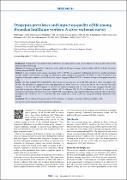| dc.contributor.author | Bitwayiki, Remy | |
| dc.contributor.author | Orikiiriza, Judy T | |
| dc.contributor.author | Kateera, Fredrick | |
| dc.contributor.author | Bihizimana, Pascal | |
| dc.contributor.author | Karenzi, Ben | |
| dc.contributor.author | Kyamanywa, Patrick | |
| dc.contributor.author | Walker, Tim D | |
| dc.date.accessioned | 2022-04-11T10:19:28Z | |
| dc.date.available | 2022-04-11T10:19:28Z | |
| dc.date.issued | 2015 | |
| dc.identifier.citation | Bitwayiki, R., Orikiiriza, J.T., Kateera, F., Bihizimana, P., Karenzi, B., Kyamanywa, P. and Walker, T.D., 2015. Dyspepsia prevalence and impact on quality of life among Rwandan healthcare workers: A cross-sectional survey. South African Medical Journal, 105(12). | en_US |
| dc.identifier.issn | 0256-9574 / 2078-5135 | |
| dc.identifier.uri | http://hdl.handle.net/20.500.12280/2937 | |
| dc.description.abstract | Background. Dyspepsia has been demonstrated worldwide to have major personal and societal impacts, but data on the burden of this disease in Africa are lacking.
Objective. To document the prevalence of dyspepsia and its quality-of-life impact among healthcare workers (HCWs) at Butare University Teaching Hospital (BUTH), Rwanda.
Methods. A cross-sectional survey among consenting HCWs at BUTH was conducted. Multilingual interviewers guided participants through validated questionnaires, including the Short-Form Leeds Dyspepsia Questionnaire (SF-LDQ), to detect the presence and frequency of dyspeptic symptoms, and the Short-Form Nepean Dyspepsia Index (SF-NDI), to examine the impact of dyspepsia on quality
of life.
Results. The study included 378 enrolled HCWs, all of whom provided responses to the SF-LDQ and 356 of whom responded to the SF-NDI. The prevalence of dyspepsia in the study population was 38.9% (147/378). Of these 147 HCWs, 79 (53.7%) had very mild dyspepsia, 33 (22.4%) had mild dyspepsia, 20 (13.6%) had moderate dyspepsia and 15 (10.2%) had severe dyspepsia. Females were more likely to complain of dyspepsia than males (98/206 v. 49/172; odds ratio (OR) 2.3; 95% confidence interval (CI) 1.5 - 3.5; p<0.001). Participants with dyspepsia of at least mild severity had SF-NDI scores reflecting reduced quality of life when compared with non-dyspeptic participants (OR 17.0; 95% CI 5.0 - 57.1; p<0.001), with most marked effects on the ‘tension’ and ‘eating and drinking’ subdomains of the
SF-NDI.
Conclusion. The prevalence of dyspepsia among HCWs in Rwanda is high and is associated with lowered quality of life | en_US |
| dc.language.iso | en | en_US |
| dc.publisher | Sa Medical Assoc , Block F Castle Walk Corporate Park, Nossob Street, Erasmuskloof Ext3, Pretoria, South Africa, 0002 | en_US |
| dc.relation.ispartofseries | South African Medical Journal;105(12) | |
| dc.subject | Dyspepsia | en_US |
| dc.subject | Prevalence | en_US |
| dc.subject | Quality of life | en_US |
| dc.subject | Rwandan healthcare workers | en_US |
| dc.title | Dyspepsia Prevalence and Impact on Quality of Life Among Rwandan Healthcare Workers: A Cross-sectional Survey | en_US |
| dc.type | Article | en_US |


